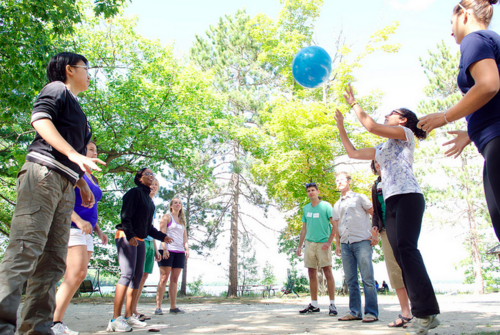
One of the hardest things (besides organising, running and maintaining!) a community group event is getting people to gel together at the beginning meeting(s). Using ice breakers to get people to know each other better is an important part of starting any community group where the members are from different areas and backgrounds.
This page is intended to keep growing as you add your ideas and experiences for suitable ice breakers for community groups.
Conversation starters[edit | edit source]
Use some form of conversation starter to get people talking to each other in pairs, trios or larger groups. The following list of possible questions or explanation prompts can be written on such things as a board, pieces of paper, blocks, posters, iPads, etc. The medium used will depend on how you divide up the attendees, how you run the session and what resources are available. Think about whether it's easiest to have one central board that everyone can see or a variety of places, or whether you'd rather the prompts be a surprise, such as handing them around on folded pieces of paper to be unfolded by the attendee who takes it.
As for the questions or explanation prompts, choose them according to the sorts of things you'd like to get the attendees to talk about. If you want lighthearted, fun banter, stick to lighter, fun prompts; if you want the attendees to get to the point of their involvement quickly, then use more directed prompts relevant to your group's purpose.
The questions or explanation prompts can include:
Lighter topics[edit | edit source]
- Describe yourself
- If you were a colour, what colour would you be?
- If your were an animal, what animal would you be?
- Favourite colour
- Favourite movie/book/show/music, etc.
- What is your favourite hobby?
- What are you good at?
- What are your bad habits? Good habits?
- Who is your favourite famous person?
More direct topics[edit | edit source]
- Explain what brought you to this group
- What do you care about most in the world? And why.
- What do you feel personally responsible in life?
- If you had to get your street neighbours to come along to this event, what would you tell them?
And so on...
Two truths and a lie[edit | edit source]
This is a common game used with English as a Second Language students at intermediate level, as it helps classmates to learn more about each other and is a lot of fun. Participants have to write down three basic facts about themselves. Two of these must be a truth, the third a lie. When everyone is done, start with one member of the group. Have this person read out the three statements, then have others in the group ask questions about each statement, in an attempt to work out the truth. After a few questions, have the whole group vote on which of the three statements is not the truth. Then the person reveals the lie. Pass on to the next person until it seems that people have learned a bit more about each other.
Finding commonalities[edit | edit source]
This is both a fun way to find out common connections with each other and a bit of movement to get everyone active temporarily. The group facilitator has a list of likely commonalities within the group. Ask all participants to stand in a long line, no particular order. At this stage, if friends gravitate together, that's fine, they'll probably end up in different places.
Begin reading out the commonalities. For example, who is a mother/father? Stand in X corner. Who has a dog? Stand in X corner. Who likes swimming? Stand in X corner. Who lives near water? Stand in X corner? Continue until you feel people have gathered into enough little groups for you to break them off in that group to work together on some other ice breakers.
Tell me about you and I'll tell everyone else[edit | edit source]
Divide everyone into pairs. Make it clear they must not know each other already, to choose a partner they've yet to know. Give each pair two minutes or so to ask three basic questions: Name, occupation/hobby and something unusual about themselves. Each person in the pair must then come back and introduce the other person in the pair to the rest of the group. You should find quite a few of the newcomers gel very quickly!